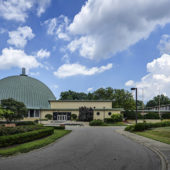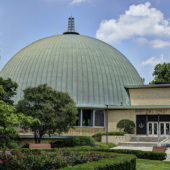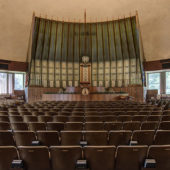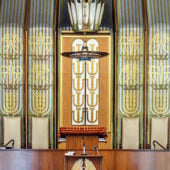A distinctive and significant example of Art Deco – Bauhaus architecture.
The Park Synagogue has its origins in two Orthodox Jewish congregations: Anshe Emet and Beth Tefilo congregations. Anshe Emeth was founded in 1869 by Polish Jews who lived originally in downtown Cleveland. By 1917, Cleveland’s Jews began relocating eastward, which led Anshe Emeth’s leadership to merge with Beth Tefilo. The combined congregation is one of the oldest Jewish congregations in Ohio.
As Cleveland Jewry continued to move eastward, the synagogue’s leadership recognized the need to build a new facility further east. To set the stage, the congregation purchased the defunct Park School and its property in Cleveland Heights. In 1943, a day care and nursery school began functioning there, and an adjacent lot of 21 acres was purchased from John D. Rockefeller. In 1945, a fire broke out, destroying most of the old Park School buildings, as well as the synagogue’s library and Torah scrolls. Erich Mendelsohn was hired to design the new synagogue. Completed in 1950, Park Synagogue is considered a significant example of modern synagogue design; one writer comments that its “adventurous use of space is masterly; there are surprises round every corner and unexpected vistas at every turn.”
Erich Mendelsohn was born in East Prussia. In 1906 he began the study of economics at the University of Munich but by 1908 he began studying architecture. Upon his return from World War I he began practicing in Berlin. Along with Mies van der Rohe and Walter Gropius he was one of the founders of Der Ring, a progressive architecture group. While heavily influenced by both Bauhaus and Art Deco styles, Mendelsohn’s work has a strong and clear geometric character that is distinctly his own.
In the spring of 1933, in the wake of growing antisemitism and the rise of the Nazis in Germany, he fled to England. His fortune was seized by the Nazis, his name struck from the list of the German Architects’ Union, and he was excluded from the Prussian Academy of Arts. From 1941 until his death, Mendelsohn lived in the United States and taught at the University of California, Berkeley. Until the end of World War II his activities were limited by his immigration status to lectures and publications. However, he also served as an advisor to the U.S. government. For instance, in 1943 he collaborated with the U.S. Army and Standard Oil in order to build “German Village”, a set of replicas of typical German working-class housing estates, which would be of key importance in acquiring the know-how and experience necessary to carry out the firebombing of Berlin. In 1945 he established himself in San Francisco. From then until his death in 1953 he undertook various projects, mostly for Jewish communities.







